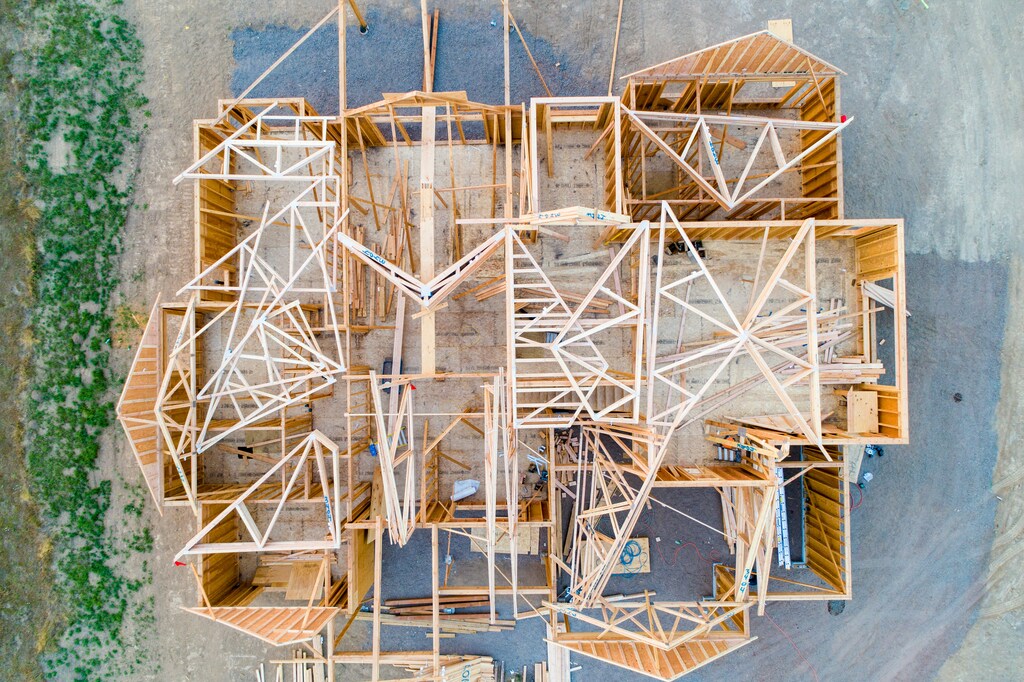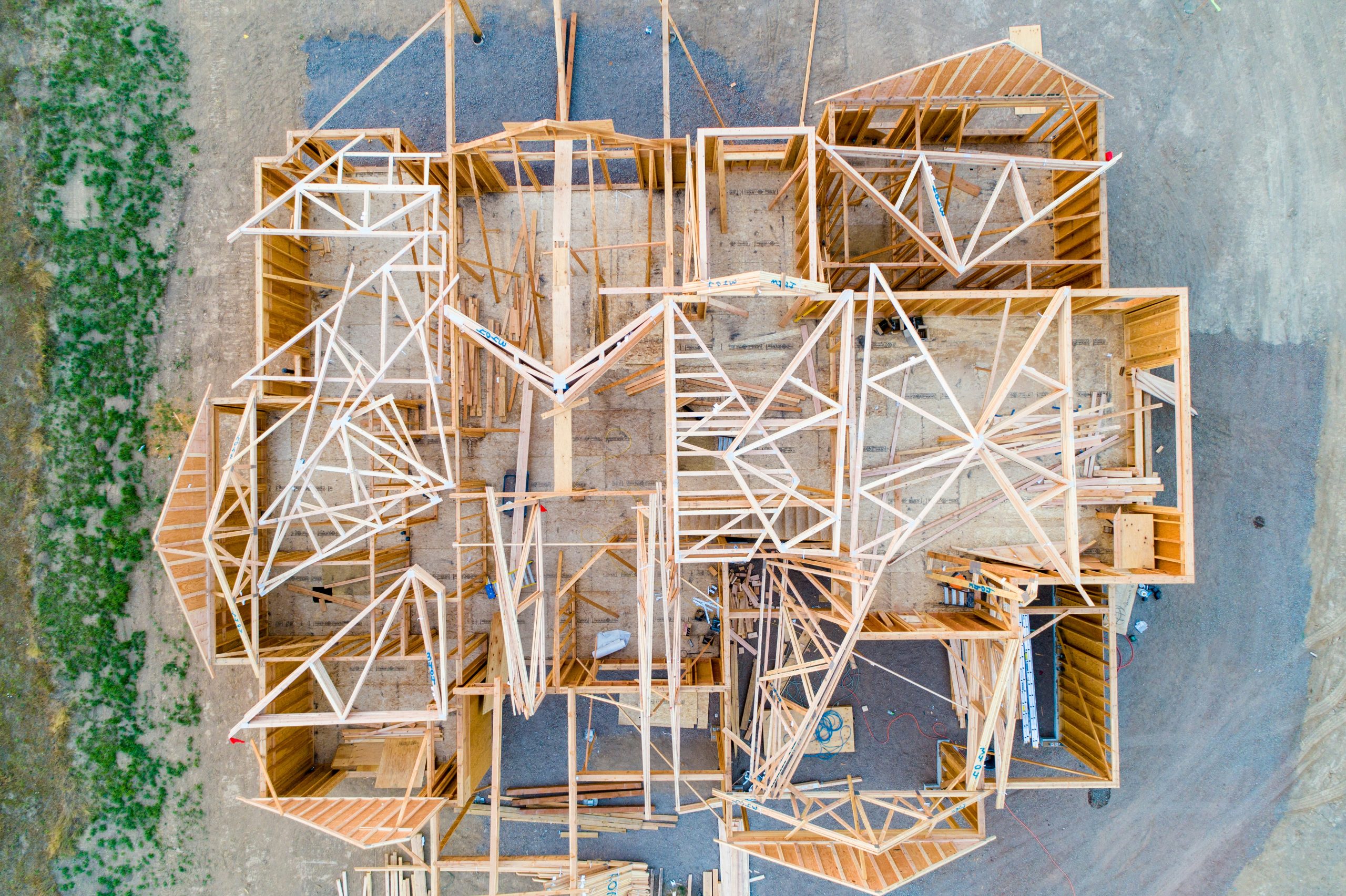Intro
The construction industry is constantly evolving, and one of the most significant advancements in recent years is the adoption of the design-build construction model. This method revolutionizes the way projects are planned and executed, offering a more streamlined and efficient approach compared to traditional construction methods. But what exactly does design-build mean, and why is it becoming increasingly popular, particularly for projects in places like Carlsbad, Del Mar, and Rancho Santa Fe? Let’s delve into the design-build construction model, its benefits, and its applications in both commercial and residential projects across North County.

Photo by Avel Chuklanov on Unsplash
What is the Design-Build Construction Model?
At its core, the design-build model is a project delivery method that combines the design and construction phases into a single contract. Unlike the traditional design-bid-build model, where the design and construction are handled separately, the design-build method integrates both aspects from the beginning. This means that the design and build contractors work collaboratively from the project’s inception to its completion, ensuring a smoother and more cohesive process.
Defining Design-Build
In the design-build method, a single point of responsibility means that one entity—usually the design-build firm or contractor—is responsible for both the design and the construction of the project. This approach minimizes potential conflicts and miscommunications that often arise when multiple parties are involved. By having a unified team, the design-build process results in faster project delivery and cost savings, which is ideal for complex custom home builds or commercial developments in high-demand areas like Rancho Santa Fe.
Single Point of Responsibility
The concept of a single point of responsibility implies that one firm is accountable for the entire project’s success. This reduces risks for the client, as there’s no ambiguity over who is responsible for handling any potential issues that arise during the project. This clarity streamlines decision-making and problem-solving, creating a more efficient workflow—a critical advantage when working on high-end residential projects with tight timelines.
Integration of Teams
One of the key strengths of the design-build model is the integration of the design and construction teams. This ensures that everyone involved shares the same goals and vision from the outset. The collaborative nature of this approach leads to innovative solutions, as designers and builders bring their unique perspectives to the table early in the process. Such synergy is vital for addressing complex challenges creatively, especially in custom home builds where aesthetics, functionality, and practicality must align seamlessly.
Reduced Miscommunication
By consolidating design and construction responsibilities under one contract, the potential for miscommunication is significantly reduced. When different teams work from separate contracts or locations, misunderstandings are common, leading to delays and errors. A unified design-build team fosters clear communication, ensuring that all parties are on the same page throughout the project. This is particularly valuable for clients in North County, where seamless execution is crucial for maintaining quality and meeting project timelines in competitive real estate markets.
Benefits of the Design-Build Method
The design-build construction model offers numerous advantages over traditional construction methods. Here are some of the key benefits:
1.Streamlined Communication
With a single point of contact, communication is more straightforward and efficient. The design and build contractors work together from the start, reducing the chances of misunderstandings and ensuring that everyone is on the same page throughout the project.
Enhanced Collaboration
The design-build model fosters enhanced collaboration, as the design and construction teams are aligned from the outset. This alignment ensures that all parties work towards common goals, leading to more innovative and effective solutions. Regular meetings and updates keep everyone informed and engaged.
Real-Time Problem Solving
Issues that arise during construction can be addressed in real-time, thanks to the close collaboration between teams. This proactive approach minimizes delays and allows for immediate adjustments. Real-time problem-solving is a hallmark of the design-build model, resulting in smoother project execution.
Consistent Feedback Loops
Feedback loops are integral to the design-build process, allowing for constant communication between stakeholders. This continuous feedback ensures that any deviations from the original plan are quickly identified and corrected. It helps maintain the quality and integrity of the project.
2. Faster Project Delivery
The integration of design and construction phases in a design-build contract means that the project can move forward without delays. The design build project delivery method allows for overlapping of phases, which can significantly reduce the overall timeline.
Overlapping Phases
By overlapping design and construction phases, the project can progress more rapidly. This approach eliminates the waiting periods typical in traditional models, where construction cannot begin until design is fully completed. Faster project delivery means quicker realization of the client’s vision.
Accelerated Decision-Making
The unified team structure in design-build projects facilitates quicker decision-making. With all relevant parties working together, decisions can be made efficiently without waiting for external approvals. This speed in decision-making is crucial for maintaining momentum and meeting tight deadlines.
Early Identification of Challenges
Potential challenges are identified early in the design-build process, allowing for swift resolution. Early identification prevents minor issues from escalating into major roadblocks, ensuring the project stays on track. This proactive approach is a significant advantage of the design-build model.
3. Cost Savings
Because the design and construction teams collaborate from the outset, potential issues can be identified and addressed early, reducing the risk of costly changes or delays. The design-build delivery method also encourages innovative solutions that can lead to cost efficiencies.
Budgeting and Cost Control
Budgeting is more precise in the design-build model, with detailed cost estimates provided early in the process. Continuous cost control measures ensure that the project remains within budget. This financial oversight is crucial for avoiding unexpected expenses.
Value Engineering
Value engineering is an integral part of the design-build process, where cost-effective alternatives are explored without compromising quality. This practice often results in innovative solutions that enhance the project’s value. By prioritizing functionality and efficiency, value engineering optimizes resources.
Minimized Change Orders
Change orders, which can significantly inflate project costs, are minimized in the design-build model. The close collaboration between design and construction teams helps identify and resolve issues before they necessitate costly changes. This proactive approach saves both time and money.
4. Improved Quality
With a unified team focused on the project’s success, the design-build construction process often results in higher-quality outcomes. The collaborative nature of the model ensures that design and build contractors are aligned in their goals and work together to achieve the best possible results.
Quality Assurance from the Start
Quality assurance is embedded in every phase of the design-build process. From initial design to final construction, stringent quality control measures ensure that standards are met. This commitment to quality from the outset sets the tone for the entire project.
Innovation in Design and Construction
The collaborative environment of the design-build model encourages innovation. With both designers and builders contributing ideas, creative solutions are developed that enhance the project’s functionality and aesthetics. This innovative spirit often leads to superior results.
Continuous Monitoring and Adjustments
Continuous monitoring throughout the project allows for timely adjustments and improvements. This vigilance ensures that the project remains aligned with the client’s vision and quality expectations. The ability to make real-time adjustments is a critical quality advantage.
Applications of Design-Build in Various Sectors
The design-build model is versatile and can be applied to a wide range of projects, from commercial to residential and industrial construction.
Design-Build in Commercial Construction
Design-build commercial construction is particularly popular due to its efficiency and cost-effectiveness. Businesses often have tight deadlines and budgets, and the design-build method offers a solution that meets these demands. Design-build firms can handle everything from office buildings to retail spaces, ensuring that projects are completed on time and within budget.
Office Buildings
In the realm of office buildings, the design-build model allows for rapid construction that meets the dynamic needs of businesses. The integration of design and construction phases ensures that office spaces are optimized for functionality and aesthetics. This approach is particularly beneficial in urban areas where speed and efficiency are paramount.
Retail Spaces
Retail projects benefit significantly from the design-build model due to the need for quick market entry. The streamlined process enables retail spaces to be constructed and opened swiftly, allowing businesses to capitalize on market opportunities. Design-build contractors ensure that retail spaces are both attractive and functional.
Hospitality and Mixed-Use Developments
The hospitality industry and mixed-use developments also leverage the design-build model for its efficiency. Hotels, resorts, and multi-purpose complexes require careful coordination of design and construction, which the design-build method facilitates. This approach ensures that these complex projects are delivered on time and within budget.
Residential Design-Build Firms
For residential projects, the design-build model provides homeowners with a seamless experience. Residential design build firms offer a range of services, from remodeling to new home construction. By working with a single entity, homeowners can enjoy a more cohesive and less stressful building process.
Custom Home Builds
Custom home building is a significant area where the design-build model excels. Homeowners can work closely with design-build firms to tailor every aspect of their dream home. This level of personalization ensures that the final product reflects the homeowner’s unique tastes and lifestyle.
Home Renovations
Home renovations benefit from the design-build model’s efficiency and coordination. Whether updating a kitchen or adding a new room, the streamlined process minimizes disruption to the homeowner’s life. The design-build approach ensures that renovations are completed efficiently and to the highest standards.
Sustainable and Eco-Friendly Homes
Sustainability is increasingly important in residential construction, and the design-build model is well-suited to delivering eco-friendly homes. Design-build teams can integrate sustainable materials and energy-efficient technologies from the start, resulting in environmentally conscious and cost-effective homes.
Industrial Design-Build Contractors
In the industrial sector, design-build engineering is essential for projects that require specialized expertise and precision. Industrial design-build contractors are adept at managing complex projects, such as manufacturing facilities or distribution centers, where efficiency and accuracy are paramount.
Manufacturing Facilities
Manufacturing facilities require precise planning and execution, making them ideal candidates for the design-build model. The integrated approach ensures that these facilities are constructed to meet specific operational needs while adhering to strict timelines and budgets.
Distribution Centers
Distribution centers, which demand efficiency and scalability, benefit from the design-build model’s streamlined process. The ability to quickly design and construct large-scale facilities ensures that businesses can meet growing logistical demands. Design-build contractors focus on optimizing space and workflow.
Infrastructure and Utilities
Infrastructure projects, such as utilities and transport systems, often employ the design-build model for its efficiency and risk management capabilities. These projects require careful coordination and expertise, which the design-build approach provides. It ensures that infrastructure developments are delivered on schedule and meet regulatory requirements.
The Design-Build Process
Understanding the design-build process is crucial for anyone considering this model for their project. Here’s an overview of how the process typically unfolds:
1. Initial Consultation
The process begins with a consultation between the client and the design-build construction company. During this phase, the client’s needs, budget, and timeline are discussed.
Needs Assessment
A thorough needs assessment is conducted during the initial consultation to understand the client’s vision and objectives. This assessment sets the foundation for the entire project, ensuring that all subsequent phases align with the client’s goals.
Budget Planning
Budget planning is a critical component of the initial consultation. The design-build firm provides a detailed cost estimate, allowing the client to make informed decisions. This transparency helps prevent financial surprises later in the project.
Timeline Establishment
Establishing a realistic timeline is essential during the initial consultation. The design-build firm works with the client to create a schedule that accommodates their needs and expectations. This timeline serves as a roadmap for the entire project.
2. Design Development
The design team works closely with the client to develop a design that meets their requirements. This phase involves creating detailed plans and specifications.
Conceptual Design
The conceptual design phase involves translating the client’s vision into preliminary drawings and concepts. This creative process allows the client to visualize the project and make initial adjustments. Collaboration between the client and design team is crucial at this stage.
Detailed Design
Once the conceptual design is approved, the detailed design phase begins. This involves creating comprehensive plans and specifications that outline every aspect of the project. Detailed design ensures that all elements are precisely defined before construction begins.
Client Feedback and Approval
Client feedback is actively sought throughout the design development process. This iterative approach allows for adjustments based on the client’s input, ensuring that the final design aligns with their vision. Approval from the client marks the transition to the construction phase.
3. Construction Planning
Once the design is finalized, the construction team prepares for the building phase. This includes obtaining necessary permits, ordering materials, and scheduling work.
Permit Acquisition
Obtaining the necessary permits is a critical step in construction planning. The design-build firm manages this process, ensuring that all legal and regulatory requirements are met. This proactive approach prevents delays during construction.
Material Procurement
Material procurement involves sourcing the necessary materials for the project. The design-build firm leverages its network of suppliers to secure high-quality materials at competitive prices. Timely procurement is essential for maintaining the construction schedule.
Work Scheduling
Effective work scheduling ensures that construction progresses smoothly and efficiently. The design-build firm coordinates the various trades and subcontractors, optimizing the sequence of tasks to minimize downtime. This meticulous planning is key to meeting deadlines.
4. Construction
The construction phase is where the project comes to life. The design-build general contractor oversees the construction, ensuring that the project is completed according to the plans and specifications.
Site Preparation
Site preparation is the first step in the construction phase, involving clearing, grading, and setting up the site for building. This foundational work is essential for ensuring a stable and secure construction environment.
Building Execution
Building execution involves the actual construction of the project, from laying the foundation to finishing the interiors. The design-build team closely monitors progress, ensuring that each phase is completed to the highest standards.
Quality Control
Quality control measures are implemented throughout the construction phase to ensure that the project meets all specifications and standards. Regular inspections and testing are conducted to maintain the integrity and quality of the build.
5. Project Completion
Upon completion, the project is reviewed to ensure that it meets the client’s expectations. Any final adjustments are made, and the project is handed over to the client.
Final Inspection
A final inspection is conducted to verify that the project has been completed to the agreed-upon specifications. This inspection ensures that all aspects of the build meet quality and safety standards.
Client Walkthrough
The client is invited for a walkthrough of the completed project. This walkthrough allows the client to see the final product and identify any areas that may need adjustment. It is an opportunity for the client to provide feedback before project handover.
Handover and Documentation
The project is officially handed over to the client, along with all necessary documentation. This includes warranties, maintenance instructions, and as-built drawings. The handover marks the successful completion of the design-build process.
Choosing the Right Design-Build Company
Selecting the right design-build company is critical to the success of your project. Here are some tips to help you make an informed decision:
Experience and Expertise
Experience is a key factor when choosing a design-build firm. Look for companies with a proven track record in projects similar to yours. Their expertise will be invaluable in navigating the complexities of your project.
Reputation and References
Research the company’s reputation through reviews, testimonials, and references. A company with a strong reputation is likely to deliver high-quality results. Speaking with past clients can provide insights into the firm’s reliability and professionalism.
Communication and Transparency
Ensure that the company prioritizes clear and open communication. A transparent approach to project management fosters trust and collaboration. Choose a firm that is forthcoming about costs, timelines, and potential challenges.
Innovation and Adaptability
Look for a design-build firm that embraces innovation and adaptability. Their willingness to explore new technologies and methods can enhance your project’s outcome. A firm that adapitates to changing circumstances is better equipped to handle unforeseen challenges.
The design-build construction model offers a modern, efficient approach to project delivery. By integrating design and construction phases, this method provides numerous benefits, including streamlined communication, faster project delivery, cost savings, and improved quality. Whether you’re planning a commercial, residential, or industrial project, understanding the design-build process and choosing the right design-build firm can help ensure a successful outcome.
Ready to Get Started?
Whether you’re building your dream home, expanding your commercial footprint, or overseeing a large-scale public project, the design-build model can deliver a smoother, more successful outcome. Contact us today to learn more about how our design-build team can bring your vision to life—efficiently, effectively, and within budget.

